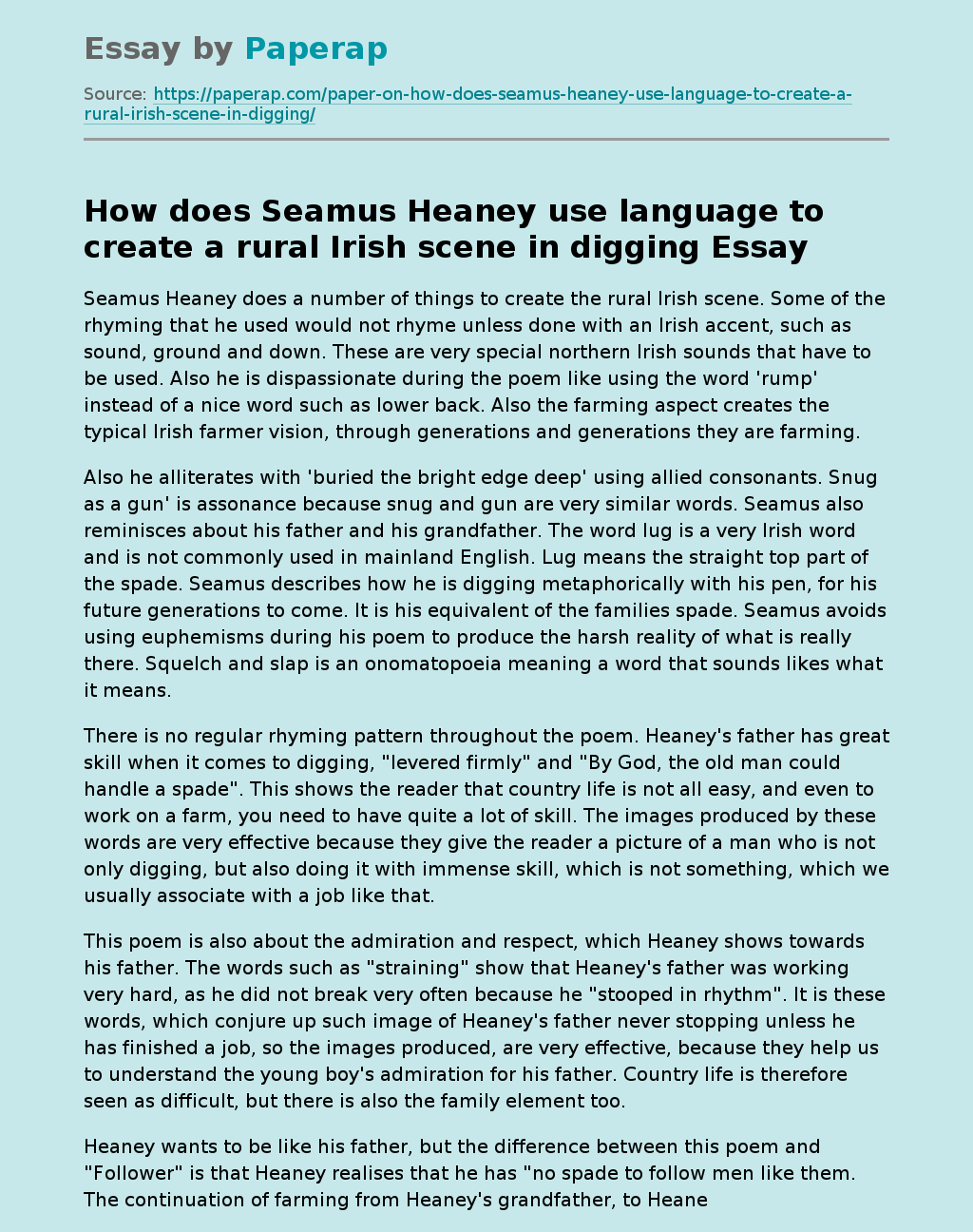How does Seamus Heaney use language to create a rural Irish scene in digging
Seamus Heaney does a number of things to create the rural Irish scene. Some of the rhyming that he used would not rhyme unless done with an Irish accent, such as sound, ground and down. These are very special northern Irish sounds that have to be used. Also he is dispassionate during the poem like using the word ‘rump’ instead of a nice word such as lower back. Also the farming aspect creates the typical Irish farmer vision, through generations and generations they are farming.
Also he alliterates with ‘buried the bright edge deep’ using allied consonants. Snug as a gun’ is assonance because snug and gun are very similar words. Seamus also reminisces about his father and his grandfather. The word lug is a very Irish word and is not commonly used in mainland English. Lug means the straight top part of the spade. Seamus describes how he is digging metaphorically with his pen, for his future generations to come.
It is his equivalent of the families spade. Seamus avoids using euphemisms during his poem to produce the harsh reality of what is really there. Squelch and slap is an onomatopoeia meaning a word that sounds likes what it means.
There is no regular rhyming pattern throughout the poem. Heaney’s father has great skill when it comes to digging, “levered firmly” and “By God, the old man could handle a spade”. This shows the reader that country life is not all easy, and even to work on a farm, you need to have quite a lot of skill.
The images produced by these words are very effective because they give the reader a picture of a man who is not only digging, but also doing it with immense skill, which is not something, which we usually associate with a job like that.
This poem is also about the admiration and respect, which Heaney shows towards his father. The words such as “straining” show that Heaney’s father was working very hard, as he did not break very often because he “stooped in rhythm”. It is these words, which conjure up such image of Heaney’s father never stopping unless he has finished a job, so the images produced, are very effective, because they help us to understand the young boy’s admiration for his father. Country life is therefore seen as difficult, but there is also the family element too.
Heaney wants to be like his father, but the difference between this poem and “Follower” is that Heaney realises that he has “no spade to follow men like them. The continuation of farming from Heaney’s grandfather, to Heaney’s father, “the old man could handle a spade. Just like his old man” shows the reader that country life is very family orientated, and professions are often carried down from father to son. The images of Heaney’s father being taught to dig by his father are very powerful and effective, because they show the reader the strong bonds between people on a farm, and in country life generally.
The last line, “The squat pen rests. I’ll dig with it. ” show that in the country, it is often expected that people like Heaney will follow in their father’s footsteps, but Heaney is seen here to choose to be a writer. The images of Heaney digging out his memories with pen are very effective because the reader can visualise the likeness between poetry and farming. However, the image is also a surprise, because Heaney says in “Follower” that he wants to be like his father, but here he has changed his mind.
There are three time stages throughout the poem. He talks about himself in the present tense. He speaks of himself in a poetic style. He talks about his father in both the past and present tense. For the present it is very poetic and skilled poetry he unromantically describes him as a ‘straining rump’ but when he is talking of his father in the past tense it is a heroic, tense relationship. It is a vision of a small boy looking up at his father. The phrase ‘bury the bright edge deep’ is like a scene out a gladiator in a battle.
He talks about it very descriptively ‘nicking and sticking – going down and down. This poem consists of a free-flowing memory. It begins with him seeing his father in the present digging in flowerbeds, which then flows to the potato digging that, was done when he was a child, which flows to his grandfather digging up peat. This is like a self-justification of himself at the end of the poem, when he metaphorically digs with his pen like his forefathers did with a spade.
How does Seamus Heaney use language to create a rural Irish scene in digging. (2017, Oct 17). Retrieved from https://paperap.com/paper-on-how-does-seamus-heaney-use-language-to-create-a-rural-irish-scene-in-digging/

